Beyond Causing Diseases: The Application of Microorganisms in Pests and Diseases Control
Good day friends and welcome to my Blog
This time around, I will open our minds towards recent breakthroughs in which microbiologist has applied microorganisms with a focus on the control of Plant Pests (Biopestides) and Diseases (Biocontrol).
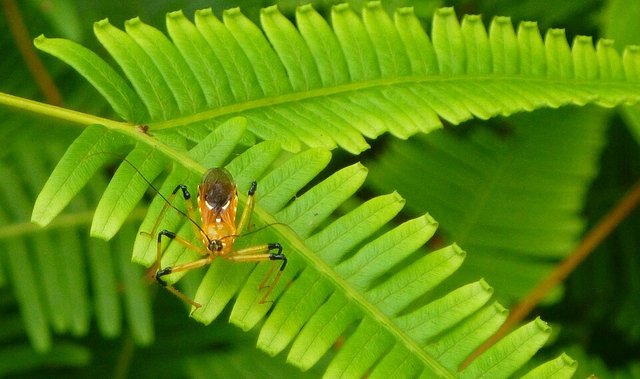
Green Leaf Bug Public domain: Pixabay
The major reason why many developing countries are experiencing food insecurity is because of the low productivity in their food production. The food security of any country is majorly determined by their agricultural input. Most unproductive agricultural system was as a result of the infestation of Pests and Diseases. To prove this fact, here are the reports of some regions that have experienced and/or experiencing food insecurity due to pre and post harvest losses.
According to the Centre for Agriculture and Biosciences International (CABI); Africa tops the list with a percentage losses at 49%, followed by Asia (47%), the former Soviet Union and the Latin America (both at 41%) source
While according to the Food and Agricultural Organization of the United Nations (FAO); countries within Africa, Asia and Central America have suffered more due to losses to pests and diseases source
From these reports, It is evident that Pests and Diseases are a great thorn to food security which results in malnutrition. The alarming thing about these reports is that besides Pests, microorganisms are the culprit that caused harm to these farm crops.
An ancient adage says in my dialect, “were lafi n wo were” which literarily means “use the same cause of a problem for its solution”
To me, this was what prompted the reasoning that led to the modern development of microbes as Biopesticides and Biocontrol agents. Before I proceed, let me remind you that Biocontrol agents are microorganisms that reduce the incidence or severity of plant diseases or pests. In recent times, Its use is the most adopted method based on health and environmental grounds. Now let me briefly discuss the methods that have been adopted in the past.
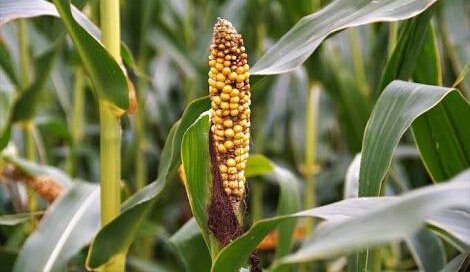-1.jpg)
Corn hair diseases Public domain: Pixabay
A look at previous advances to control Pests and Diseases
Plant diseases needs to be tamed so as to ensure the food security of any nation. Scientists (Agronomists, Botanists, Microbiologist) have earnestly tried to control these Pests and Diseases in the pasts. Diverse approaches that have been used are:
1. Cultural Control:
This is the oldest and broadest method of controlling plant pests and diseases. In ancient times, different methods such as bush fallowing, shifting cultivation, roguing, seed selection, crop rotation, solarization, altering dates of planting, intercropping and other farming system had been used to control pest and diseases, it is however glaring that this might not be relevant in the modern days.
2. Physical control:
Aside the handpicking of insect/pest on farm land which is outrightly outdated, the development of the hot water smut disease treatment method of Jensen in 1887, hot air treatment for the control of virus by Kunkal in Peach yellow and the Solar energy loose smut treatment method of Lutlzra was a boost in diseases control in the their era source. However, they are only effective in controlling nematodes and are also outdated.
3. Plant quarantine method:
In the past, legal embargo was laid on the transition of agricultural products for the purpose of exclusion, prevention or delay to prevent the spread of plant pests and diseases in areas where there was no outbreak. This however is not the best precaution to take in pest/diseases control.
4. Chemical control:
The use of agro chemicals to treat Soil inorder to control the soil borne diseases that infect seeds or seedlings has been in vogue for some time now. Diverse chemicals such as Captan, Thiram, Organo-mercurials, PCNB, Ethylene dibromide formalin, Perelan, Blitox, Cuprokyt, Cuprosanand Fytolan etc source have been tried by farmers over time. These trials have been serially abused and the implications are are been revealed in terms of pest/diseases resistance, health and environmental pollution.
Chemical control of weed BY Galloway, B. T. CC BY 3.0 Link
Though, these agro-chemicals have tremendously improved the global food index over the years; the consequences due to its over-use have caused more damage to human health and the environment.
However, the concerns regarding human health and environment has made scientists to seek for an alternative approach to replace hazardous agro-chemicals in improving plant resistance against phytopathogens, hence, the emergence of non-pathogenic, soil inhabiting microorganisms known as Biopestcides and Biocontrol agents.
Principle behind the use of Microorganisms as Biocontrol Agents
While discussing on the use of microorganisms as Biofertilizers in my last post, I mentioned that the mechanism is a direct method of growth promotion; however, the case of biocontrol is an indirect method of growth promotion charged with the ability to lessen or prevent the deleterious effects of phytopathogenic organisms. This is possible by the secretion of inhibitory substances and/or causing resistance to plant diseases. This is done by the following mechanisms:
i. Antagonism
Antagonisms occur during the inhibition of plant pathogens by one or more mechanisms. These mechanisms include the production lytic enzymes on the disease causing organisms, production of hydrogen cyanide, secretion of siderophore (an iron chelating agent which co-habitts microbes to deprive pathogens from Iron), and the production of Antibiotics such as the phenazines, 2,4- diacetylphloroglucinol, pyoleutorin etc source.
However, on the production of lytic enzymes such as chitinase, protease, urease etc, microorganisms make use of these enzymes to inhibit the production and infestation of pathogens. For example, Fusarium oxysporum have fusaric acid that lyses fungal pathogens; while Serratia marcescens produce chitinase to lyse Sclerotium rolfsii.
ii. Antibiosis:
The function of antibiotics as found in humans has a similar function in plants. These antibiotics are secreted by microorganisms whenever they detect an invasion thereby defending the plants from further attack by the pathogen. Antibiotics such as phenazines, pyoluteorin, hydrogen cyanide, surfactin, D-gluconic acid are produced mostly at the exponential growth phase to attack any plant pathogens.
iii. Competition for nutrients and niches
Other than biocontrol mechanism through antagonism and antibiosis, the competition for available food (nitrogen) and space is another unique mechanism used by microorganisms to defend plants from attack of pests and diseases.
Using this mechanisms, Pliego 2007 was able to isolate several strains of microorganisms that were able to compete successfully with plant pathogens and outlive them.
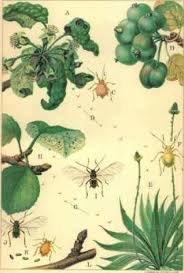.jpeg)
Biocontrol of aphids BY Quaintance, A. L. Baker, A. C.
CC BY SA 3.0 link
iv. Predation and Parasitism
Several microorganisms have successfully suppressed plant pathogens through the secretion of enzymatic compounds such as the chitinase, protease and urease which have the ability to penetrate the cell wall of a pathogen and destroy its viability.
v. Induced System Resistance (ISR)
Induced System Resistance is another mechanism used by microorganisms to cause protects plants from pathogens. This mechanism is very active against plant disease causing agents such as Bacteria, Fungi, Viruses and Pests. Through signaling, microbes have a way of sending messages to a plant (priming) whenever it detects an attack by a pathogen which then makes the plant to immediately react by the secreting toxic substances against the pathogens.
vi. Consortium of the above mechanisms
The most interesting part of the principle behind the use of Microorganisms as Biopestides and Biocontrol agents is that it has the ability to take advantage of all the listed mechanisms in suppressing plant pathogens. This means that whenever any one of the above listed mechanisms was compromised by a pathogen or in the case of resistance to anyone of the mechanisms, then the pathogen is not likely to survive another mechanism.
In-vitro and In-vivo application of Biocontrol/Biopesticides ability of Microorganisms
Laboratory and field work have been successfully carried out to prove the viability of these biocontrol mechanisms. To find out about researchers who have successfully use microorganisms to control certain pests and diseases, visit this links:
The in-vitro biocontrol assay can be carried out by streaking a potential microorganism against the known plant pathogens. The barrier (clear zone) between the microorganism and the pathogen after incubation will determine the antagonistic interaction between them. However, a greenhouse and field survey can be conducted after the in-vitro assay.
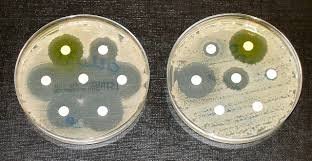.jpeg)
In-vitro Biocontrol assay BY Dr Graham Beards
CC BY SA 3.0 Link
This means that the best microorganisms with higher potentials for biocontrol would have been selected from the in-vitro assay and inoculated into the seeds to be planted before planting in a soil already contaminated with a known plant disease.
Monitoring of the seedlings will then be observed for a specific period (depending on the seed planted) every day to determine the growth (percentage germinated seed, seedling height, stem girth, number of leaves, leaf area) and the diseases symptoms (disease incidence, diseases severity, diseases reduction, percentage).
Conclusion
Interest in the use of microorganism to control plant diseases is gaining worldwide attention. The emphasis of being an environmental friendly method is what makes it a better approach to hazardous agro-chemicals, hence, the need to develop its potential for crop protection, food security and sustainable agriculture.
Thank you for Reading
All Images Used In This Article, Are Linked To The Respective Owners
| REFERENCES |
● Akintokun, A.K., Taiwo, M.O., Akintokun, P.O and Obuotor T.M. 2016. Screening of indigenous Plant Growth-Promoting Bacterial Strains for enhancing growth of Tomato (Lycopersicon esculentum Mill.) in Nigeria. Journal of Global Agriculture and Ecology. 6(2).127-135.
●Center for Agriculture and Bioscience International 2017. Improving lives by solving problems in agriculture and the environment https://www.cabi.org/projects/food-security/tackling-pests-diseases/
●Food and Agriculture Organization of the United nations 2016 Countries with food shortage worldwide http://www.fao.org/newsroom/en/news/2006/1000416/index.html
● Methods of controlling plant diseases http://www.biologydiscussion.com/plants/plant-diseases/top-4-methods-of-controlling-plant-diseases-agriculture/24146
●Pliego 2007. Selection for biocontrol bacteria antagonistic toward Rosellinia necatrix by enrichment of competitive avocado root tip colonizers https://www.researchgate.net/publication/6363199_Selection_for_biocontrol_bacteria_antagonistic_toward_Rosellinia_necatrix_by_enrichment_of_competitive_avocado_root_tip_colonizers
●Lugtenberg B. and kermilova F. 2009 Plant grwoth Promoting Bacteria https://www.researchgate.net/publication/229138683_Plant-Growth-Promoting_Rhizobacteria
If you write STEM (Science, Technology, Engineering, and Mathematics) related posts, consider joining #steemSTEM on discord here. If you are from Nigeria, you may want to include the #stemng tag in your post. You can visit this blog by @stemng for more details. You can also check this blog post by @steemstem here and this guidelines here for help on how to be a member of @steemstem. Please also check this blog post from @steemstem on proper use of images devoid of copyright issues.
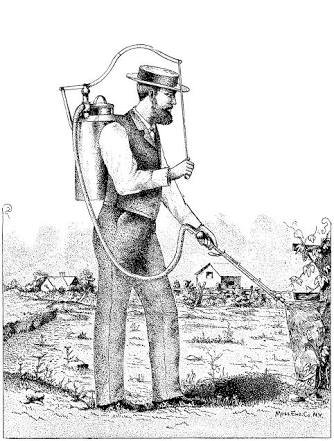.jpeg)


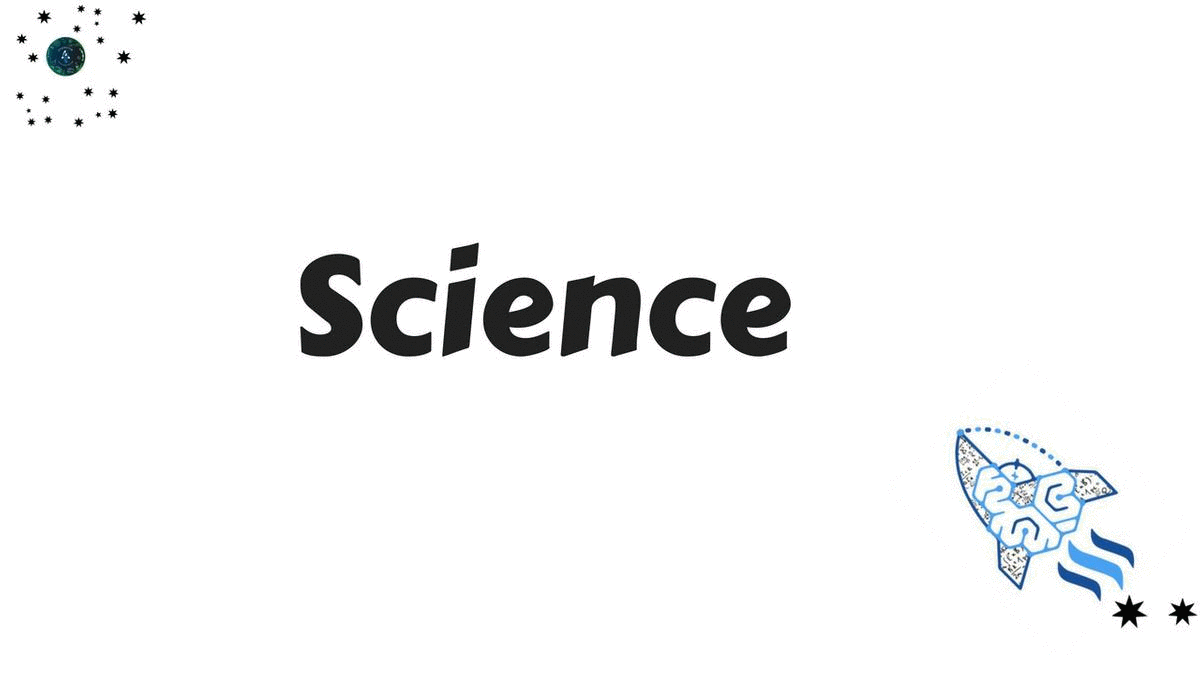
Thank you for this wonderful article.
Researches all over the world have demonstrated the use of microorganisms in the control of pests and diseases of plants.
Well presented @teemike
Thank you friend
This post has been voted on by the steemstem curation team and voting trail.
There is more to SteemSTEM than just writing posts, check here for some more tips on being a community member. You can also join our discord here to get to know the rest of the community!
Thank you @steemstem
Congratulations @teemike! You have completed the following achievement on Steemit and have been rewarded with new badge(s) :
Click on the badge to view your Board of Honor.
If you no longer want to receive notifications, reply to this comment with the word
STOPTo support your work, I also upvoted your post!
Thank you
Congratulations @teemike! You have completed the following achievement on Steemit and have been rewarded with new badge(s) :
Click on the badge to view your Board of Honor.
If you no longer want to receive notifications, reply to this comment with the word
STOPCongratulations @teemike! You have completed the following achievement on Steemit and have been rewarded with new badge(s) :
Click on the badge to view your Board of Honor.
If you no longer want to receive notifications, reply to this comment with the word
STOP